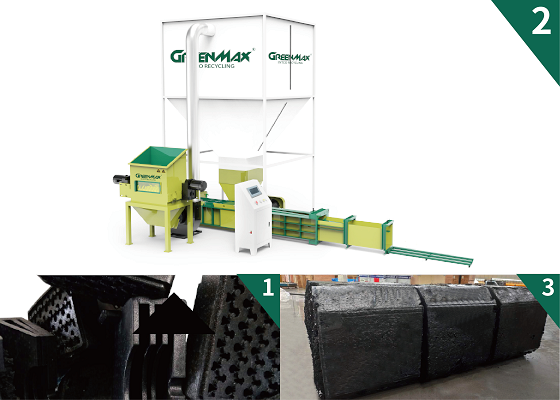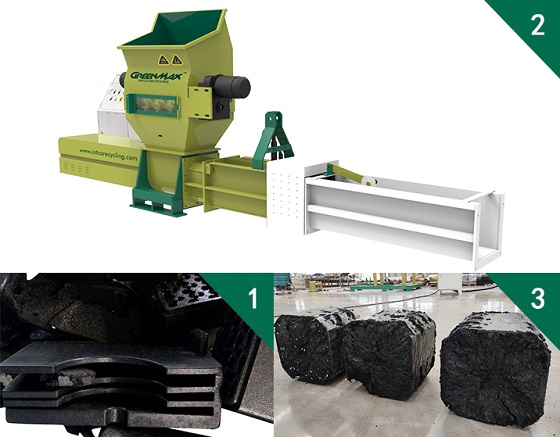EPP Foam in the Vehicle Industry and Innovative Recycling Solutions
Foam, especially polystyrene foam, is widely used in the automotive industry for its lightweight, insulating and cushioning properties. From interior components to packaging materials, foam plays a vital role in improving safety, comfort and efficiency. However, the growing concern for environmental sustainability has raised questions about the impact of polystyrene foam waste on the planet. In this article, we will take a closer look at the use of foam in the automotive industry and explore innovative recycling solutions designed to minimize its environmental footprint.

EPS & EPP foam has become an integral part of the automotive industry, contributing to both aesthetics and functionality. Below are some of the key areas where foam is commonly used:
INTERIOR PIECES: Foam is used in the manufacture of interior parts such as seats, headrests, armrests and instrument panels. Its soft texture can provide passengers with a comfortable sense of contact, while also acting as a cushion in the event of a vehicle collision, reducing the risk of injury to passengers. Moreover, through the modern manufacturing process, the foam can be made into a variety of exquisite shapes and colors, and the overall interior style of the car perfectly integrated to enhance the aesthetics of the car!
Packaging and insulation: During transportation, fragile car parts are packaged in Styrofoam. In addition, they provide insulation. For example, the partition between the engine compartment and the cockpit of an automobile is often made of foam to prevent heat transfer, thus maintaining a suitable temperature in the cockpit, reducing the load on the air-conditioning system and improving the efficiency of energy utilization. Moreover, in high-temperature areas such as the exhaust pipe of an automobile, special high-temperature-resistant foam is also used for thermal insulation to protect the surrounding parts from high temperatures.

Soundproofing and vibration damping: The acoustic properties of foam help to reduce noise levels inside the vehicle and improve passenger comfort. Not only that, but shock absorbing components made of foam are also installed in the suspension and chassis areas of the vehicle to absorb vibrations coming from the road surface and make the vehicle ride smoother. When the vehicle is traveling on rough roads, these damping foams can effectively filter out both high and low frequency vibrations, providing passengers with a more comfortable driving experience.
However, despite the many significant advantages and wide applications of foam in the automotive industry, the environmental problems it brings are a growing concern as environmental awareness grows. Polystyrene foam is difficult to degrade naturally, and a large amount of discarded foam not only occupies land resources, but also may cause pollution to soil, water and air. Therefore, how to give full play to the role of foam in the automotive industry while reducing its negative impact on the environment has become an important issue that needs to be resolved in the current automotive industry.

To address this challenge, researchers and companies are actively exploring innovative recycling solutions. Some advanced technologies have been able to effectively recycle and reuse waste foam, turning it into new auto parts or other useful products. At the same time, some enterprises are also committed to researching and developing new foam materials that are more environmentally friendly and biodegradable, in order to gradually replace the traditional polystyrene foam.
Mechanical recycling: Mechanical recovery focuses on the mechanical processing of foam to create reusable raw materials. The method involves crushing, melting and granulating the foam waste to produce recycled pellets that can be used for a variety of applications.
Biodegradation technologies: Researchers are developing specific biodegradation methods that utilize specific microorganisms or enzymes to break down Styrofoam. This method is relatively environmentally friendly and the decomposition products have a low impact on the environment.
Closed-loop recycling systems with suppliers: Automakers work closely with foam suppliers to create a closed-loop recycling system. In this system, foam recovered from vehicles is returned directly to the supplier for reprocessing and reuse, reducing intermediate steps and wasted resources.
Intelligent Classification and Recycling Technology: With the help of advanced sensors and artificial intelligence technology, foam from the automobile dismantling process is intelligently classified and identified to ensure the accuracy and efficiency of recycling. At the same time, automated equipment is utilized for rapid collection and processing.
Education and publicity on foam recycling: Conduct extensive educational activities within the automotive industry to raise employees' awareness of the importance of foam recycling and encourage them to actively participate in and support recycling efforts. In addition, publicity campaigns are used to convey relevant information to consumers and to enhance public awareness of sustainable development.
Policy support and incentives: The government should formulate relevant policies to provide tax incentives, subsidies or other forms of incentives to automobile enterprises that actively adopt foam recycling solutions, in order to promote the whole industry to increase recycling efforts.
Collection management and sorting, and raising public awareness of environmental protection are also important measures to reduce the environmental footprint of foam. It is believed that in the future, through technological innovation and the joint efforts of the whole society, we will be able to realize a harmonious symbiosis with the environment while safeguarding the development of the automotive industry, and make the application of foam in the automotive industry more sustainable and environmentally friendly.

The automotive industry's reliance on foam highlights the need for sustainable solutions to manage foam waste. As technology continues to advance, innovative recycling methods hold promise for reducing the environmental impact of automotive foam. By working together, industry, policymakers and consumers can realize more recycled methods of foam use and disposal, creating a cleaner, greener future for the automotive industry and the planet.
In the future, we expect to see more investment in scientific research to develop recycling technologies that are more efficient, environmentally friendly and less costly. At the same time, the government should introduce stronger policy support and guidance to encourage enterprises to actively participate in foam recycling. Consumers should also enhance their awareness of environmental protection and pay attention to the recyclability and environmental performance of foam parts when purchasing automobile products, so as to promote the green development of the automobile industry with practical actions. Only with the concerted efforts of all parties, we can truly realize the effective management and sustainable use of foam in the automotive industry and make our home on earth more beautiful and livable.
